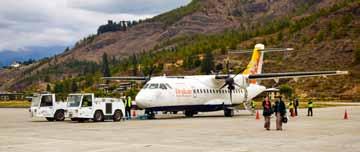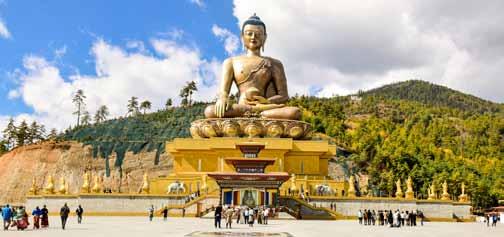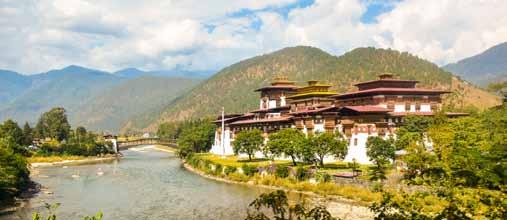
16 minute read
BHUTAN - A country with abundant Natural Beauty
from SBI Second Innings Sept 2019 issue carries Life and Career of Prof Dr Chowdari Prasad in 11-12 pages
consoled myself assuming it was a blessing in disguise.
It was in November 2018 when we were standing in a que at the Delhi airport for cheking-in, for a Paro (Bhutan) bound ‘Druk Air’ flight. The person on the counter asked me which side seats you want? Since I had no attraction for window seat, I just told him ‘Any seat will do.’ He allotted us right hand side seats. I was happy as most of the passengers from our group had been allotted right side seats and our seats were behind each other. So, I thought we can chat with each other so that the journey period of two and half hours could not be a boring one. After a period of almost 45 minutes from takeoff, the pilot informed that on the left-hand side of the plane you can observe the Himalayan ranges and could see some of the famous and important peaks. At this juncture, I realised why I was given a choice at the time of checking in. So, I had lost a good opportunity, but it was in vain now repenting. However, due to little cloudy weather the passengers hardly could enjoy the beauty of the Himalayan ranges. I
Advertisement
Paro Air Port After about two and half hours of travelling our plane landed at Paro airport, the only airport in Bhutan. The airport is located at a height of 7,300 ft. from the Mean Sea Level and supposed to be the most dangerous one as it is surrounded from all sides with high mountains and full of greenery. Hence it is difficult for landing. Due to little dangerous but difficult nature of the airport the pilots from Bhutan are considered among the 10 best (country wise) pilots of the world. It was very cold out-side when we landed there and the cool breeze welcomed us. The Paro river, one of the main tributes flows adjacent to the airport along the main road leading to Paro city. All the walls of the airport buildings had been painted with conventional paintings and arts of Bhutan. From inside also all the walls have been painted beautifully in Bhutani’s art. On the lines of the proverb ’Charity begins at home’ we found the airport very neat and clean both from outside as well as inside. When we entered the airport building for immigration, we felt as if we were entering in to a beautiful house. We could experience the hospitality, kindness of the people of Bhutan right from immigration point. In our group we were 14 tourists and the company had hired a mini bus for us. There were two guides who greeted us by bowing down and offering a white small shawl (Uparane) with smile. Bhutan, the entire country comprises of panoramic valleys, majestic Himalayas, and abundance of rare fauna and flora. The rivers, arising from the Himalayas, meander through the valleys and mesmerize with their beauty. Its long list of forts, monasteries, and other Buddhist relics, trekking spots, and
shopping areas are surely having conventional monarchy worth a visit. This country and at the same time there is also famous as a country exists democracy also. The of Dragon. ‘Druk’ means parliament is empowered even dragon. The word ‘Druk’ to impeach the King. is prefixed in case of many important names. e. g. ‘Druk Air’, ‘Drukyul Hotel’ and so on. The nation’s flag carries a picture of a dragon. The people of Bhutan have a strong belief that the ‘Dragon’ would always protect them from all the evils. 90% of the population is Buddhist. After experiencing these people for about a week, I could make out that the real meaning of Buddha Religion i. e. calmness and non-violence, peaceful nature has been fully understood by these people as they have been following the various principles of this religion truly and religiously. In each town there is one ‘Dzong’ which is known as ‘Dharmapeeth’. The main priest is known as a ‘Monk’ and their assistant is known as a ‘Lama’. The country is From Paro we proceeded to Thimphu, the capital of Bhutan. Then next day morning we went to see the ‘Budha Dordenma Statue’. The bronze-gold Buddha Dordenma Statue is among the popular Bhutan tourist places. It is 169 feet tall statue of Buddha, built at the foot of the hills in Thimphu. This iconic gold and bronze statue, is visible from almost anywhere from Thimphu City. The entire premises are very huge and has been kept very clean and tidy. Outside the temple there are other attractive statues. Inside the temple, installation of one lac small statues of Budha, measuring 12 inches in height and 25,000 statues, measuring 8 inches in height is under fast progress. This statue was installed in 2015 and is one of the greatest attractions of the tourists. Thereafter we had Stupa (Chorten) at the entrance of the ‘Budha Dordenma Statue’, Thimpu

‘Budha Dordenma Statue’, Thimpu

Wall painting of Buddha Religion
been to ‘Mitithang Takin Reserve’. This is a famous zoo in Bhutan. Takin is an animal looks like a ram and has been declared as ‘National Animal of Bhutan’. The Government has been taking maximum care to preserve this animal so as to save from its extinction. The next attraction was Dochula Pass. This is a most beautiful pass considering its panoramic view. It is located at a height of 10,500 ft. and consisting of 108 Chortens or Stupas, built in the memory of the Bhutanese soldiers who died in a war against the insurgents from India. This war was fought in 2003, by the Bhutan Army (for India) against the ‘ULFA’ organisation of Assam. The beautifully built temples and stupas, with the picturesque ‘Gangkar Puensum’ peak in the background, makes the ‘Dochula Pass’ one of the best tourist places in Bhutan. Its panoramic view gives a glimpse of the peak of the sacred Himalayan mountain – ‘Chomolhari’. However, due to cloudy weather we failed to see the Himalayan peaks covered with snow. In the neighbourhood, one can observe good number of varieties of beautiful birds and colourful butter flies. It was very cold as the mercury had dipped to 2 degrees centigrade. So, naturally we have to had a cup of hot coffee in a nearby restaurant. The next day we visited Punakha, the oldest town in Bhutan and in old days (till 1955) it used to be the capital of Bhutan. The Monastery i. e. ‘Punakha Dzong’ is like a fort and one of the popular places to see in Bhutan. Punakha Dzong is the second largest Dzong in Bhutan and is known for its brilliant structure. It speaks volumes about the beautiful stories and traditions of the Buddhist culture. The main attractions were the intricate paintings and the architecture of the fort, sacred relics of the southern Drukpa Lineage of Kagyu school of Tibetan Buddhism, and the sacred remains of ‘Ngawang Namgyal’ and the ‘Tertön Pema Lingpa’. Adjacent to the Dzong flows a river which adds to the beauty of the place. Later in the afternoon, we enjoyed the sensational rafting in this river. ‘Punakha Suspension Bridge’ is situated on the ‘Pho Chhu’ river. It is 300 Mts. long but very narrow and offers scenic views of the Punakha valley and surrounding mountains. The next place was Paro City. This place has cultural importance. The palace of the king


Photograph of Mrs. & Mr. V. V. Gandhe at ‘Dochula Pass’ Dochula Pass with Chortens

‘Punakha Zong’ on the bank of the river ‘Mo Chhu’
is worth seen as it is famous for traditional Bhutanese paintings. The ‘National Museum of Paro’ built in 1968 and set above the famous ‘Rinpung Dzong’, known as the fortress on a Heap of Jewels. ‘Rinpung Dzong’ is among the best tourist places and a classic example of Bhutanese architecture and deep-rooted traditions. The National Museum exhibits number of photographs of Indo-Bhutan friendship right from the period of Late Shri Pandit Nehru till Shri Manmohan Singh, our ExPrime Ministers with the Kings of Bhutan since long. The Museum also exhibits historical as well as geographical information on Bhutan. From contemporary paintings to ancient statues, the museum today houses about 3000 masterpieces and exhibits more than 1,500 years of cultural heritage of Bhutan. From Paro we went to ‘Chellela pass’ which is located at an altitude of 3989 Mts. It is famous for the magnificent panoramic view of the valleys, gushing waterfalls, alpine flowers, and clouds drifting above the hills. On penultimate day of our tour we had been to ‘Tiger’s Nest’ which attracts the maximum number of tourists, in general and in particular the Buddhist. Tourists from countries having Buddha religion are visiting Bhutan particularly for this place. This place is situated 20 KMs from Paro. The original name of ‘Tiger’s Nest’ is ‘Taktsang Monastery Paro’. The Monastery is located at an altitude of 10,232 ft. having beautiful hills in backdrop. It is one of the most popular and sacred monasteries of ‘Guru Rinpoche’. After getting down the Bus, we have to either climb up 3 KMs by foot or on a horse. Then the distance of 3.5 KMs has to be climbed up by foot only. After climbing around 2.5 KMs, one has to go down 450 steps in the valley and then again climb up 250 steps. Then you reach the Monastery. While returning one has to get down 250 steps first and then climb up 450 steps. Thereafter, one can come down only by foot as due to very steep/acute slope, horses are not used. There are two interesting legends related to the ‘Tiger’s Nest. These are as under: i) According to a legend related to this Taktsang (which in Tibetan language is spelled ‘Stag Tshang’), which literally means "Tigress lair", it is believed that ‘Guru Padmasambhava’ (Guru Rinpoche, founder of the ‘Meditation Cave’), flew to this location from Tibet on the back of a tigress from Khenpajong. This place was consecrated to tame the Tiger demon. According to the legend, Guru Rinpoche
flew to the site as the fiery ‘Dorje Drolo’, one of his eight manifestations, on the back of a tigress, a form assumed by his consort ‘Yeshe Tsogyal’ to subdue the local demon, ‘Singye Samdrup’. After that, he meditated in a cave for three months. It is said that when the monastery was first built, it was anchored to the cliff by the hairs of ‘Khandroma’ (female celestial beings). ii) An alternative legend holds that the monastery was built around the ‘Taktsang Senge Samdup’ Wall painting of Buddha Religion (‘Stag Tshang seng ge bsam grub’) cave, where custom holds that the Indian ‘Guru Padmasambhava’ meditated in the 8th century. He flew to this place none of us faced any health problem except tiredness after we came down. We travelled total distance of 10 KMs. on foot. from Tibet on the back of ‘Yeshe Tsogyal’ The weather was excellent as it was pretty cold a former wife of an emperor, whom he and fine sunny morning when we started. The transformed into a flying tigress for the surroundings were pleasant as the mountains purpose and landed at the cliff, which were full of greenery, the avenue was zig zag he "anointed" as the place for building a but at certain points it was dangerous due to monastery. He established Buddhism and steep ascent and slope. Each of us carried two the ‘Nyingmapa school of Mahayana sturdy sticks so we did not face any problem Buddhism’ in Bhutan, and has been while walking through the difficult hilly terrain considered the “protector saint of Bhutan”. in general and while descending in particular since due to steep slope there are chances It is said that the cave was first built in 8th of slipping down unnoticed. At many places century. In 1692 the temple was two storied on the mountains we find enormous flags of and now there are total nine temples. Through Buddha Religion, in different colours. Each the cliff a small waterfall is also flowing which flag was having five different colours which adds to the beauty of this place. We could see a indicated the five great elements. rainbow due to sunlight falling on the water fall. These elements are known as Bhumi (Earth), Out of 14 tourists from our group, 8 persons Aap or Jala, (Water), Teja or Agni, (Fire), Vayu or went up to the end of the nest. Three persons Pavan (Wind) and Vyom, Shunya or Akash (Sky were under the age of 45, and 5 were between or Space or Zero). In Hindu religion (Vedas) we 60 and 70. I was the oldest among all, being call them as ‘Panch Mahabhuta’. On some of 70. We used horses for the first three KM the flags in Bhutanese language some mantras distance so as to conserve our energy. We took were written. We were experiencing very cool almost six and half hours for the entire to and but gentle breeze and all over there were lush fro journey as we climbed very steadily but green bushes and big tall trees and due to this confidently since we had made up our mind to beautiful surrounding we were experiencing a go till end. Fortunately, despite advanced age high level of spirituality within us which took us

to a very high level of purity/sacredness. This spiritual power energised and encouraged us to achieve our main objective of reaching to the destination.
Since we visited in winter season there were large number of foreign tourists. Obviously, the majority were from south east countries pursuing/following Buddha Religion. Bhutan is having 7 lac population and as compared to India, it is a miniature country in all respects. Apart from the above description of our tour, the main objective of writing this article is to bring to the readers’ kind notice that during our short stay of 6 days in Bhutan, we could learn and experience so many good things from the people of Bhutan.
All the roads in Bhutan were found very clean and maintained in good condition, nowhere we could observe any litter or dirtiness. There are no signals on any of the roads including the capital. The drivers of the vehicles, be it two/four wheelers, carrying goods, were not sounding horns. If sounded, it was a very rare exception. All were observing self-discipline as even on main roads no traffic Police was seen. While crossing the roads one has to make use of zebra crossing only. This rule is observed very strictly otherwise heavy fine is imposed. Two-wheeler auto vehicles were seen rarely. In none of the cities we could observe cluster or gathering of people gossiping. All the day to day activities are being carried out smoothly and silently. People give importance to cleanliness everywhere. At each tourist place there were ‘paid rest rooms’, means you have to pay and use the wash room. All must make use of these paid rest rooms only. Even when we had been to ‘Tiger’s Nest’ our guide specifically advised us (rather warned) that after 3 Kms ride there is a restaurant where there are rest rooms. We must make use of those rest rooms only as thereafter the rest rooms could be located only in the premises of the ‘Tiger’s Nest. So, we had to be very careful. He also told us not to throw any litter en-route the Tiger’s Nest as it is very difficult and very cumbersome to bring it down. The same rule applied to plastic bottles. In Bhutan consumption of tobacco, smoking and use of plastic (with certain exceptions) have been banned completely. It is interesting to note that the people are following the rules religiously and found to be very particular about this.
In Bhutan medical service is limited but it is totally free. There is only one surgeon in the country and there are ‘Primary Health Centres’. These centres are manned by Nurses who have undergone training in India. These Nurses treat the patients. The ratio of Male to Female is 1:5. Therefore in hotels, shops, restaurants, and at many such places including bars the girls or women are working. In the Hotels girls are lifting the luggage. After seeing this we felt very embarrassing but then the Guide told us that it is a common feature, so do not feel shy about this. The male and female have to wear their conventional dress compulsorily at their work places. ‘Gho’ is the name for male dress whereas ‘Kira’ is for female dress. The main currency is called ‘Nultrum’. The value of their currency is equivalent to Indian currency. So, our currency with same valuation is accepted there. In Bhutan casteism is totally absent. Even the King has to marry a ‘Bhutanese Girl’. The present King in Bhutan has donated his palace to the Parliament and he has been staying in a small bungalow. In almost all hotels, restaurants, shops, residences people are displaying the photos of the King and Queen or of the ‘Royal Family’. The people of Bhutan have great respect for their King/Royal Family. When a baby is borne it is taken to their Monk (Priest) for blessings and he names the baby. During our stay in the Hotel, on one day a ‘Cultural Programme’ of young Bhutanese boys and girls was organised. They exhibited their conventional dances wearing different kinds
traditional dresses/constumes and masks. They individually and in chorus sang some Bhutanese songs. While singing they made use of an instrument resembling ‘Santur’ in our country. All the songs they sang were very sweet and nice and liked by all of us. All of us enjoyed this programme presented by them with dedication. The people of Bhutan largely respect Indians. Normally, they will not hate or envy anybody. They are very polite, happy and always found satisfied with whatever they have, despite the fact that the country is very poor. They are ever ready to help others. With all these qualities possessed by them they always remain happy and contended. Therefore, this country is also known as ‘Country of Happy People’. We are always on the forefront to imitate the developed nations. However, we should not feel shy to imbibe the above mentioned simple but highly rich values from developing nations like ‘Bhutan’ and ‘Shree Lanka’, our neighbours. We returned to Pune via Delhi on 8th November 2018, after finishing our tour of 6 days. For our return journey we specifically asked for right hand side seats of the plane. Luckily, all of us got. We were fortunate as the sky was very clear and we therefore could enjoy the bird’s eye view of the Himalayan Ranges almost for one and half hours. The pilot informed that we could see the famous peaks like Mount Everest, (8,848 Mts.) Kanchenjunga, (8,586 Mts.), Lhotse, (8,516 Mts.), Dhavalgiri, (8,167 Mts.), Manaslu, (8,163 Mts.), Annapurna, (8,091Mts.), Jomolhari, (7,326 Mts.), and Gaurishankar, (7,134 Mts.). Needless to mention politely that it was difficult for us to recognise any of these peaks. Lastly, I could say that while returning from Bhutan, we brought with us sweet and unforgettable memories of the happy people of Bhutan. These sweet memories will keep us always happy and satisfied, of course, subject to observing their life long values in our day to day life. Vilas Gandhe, General Secretary, SBIPA, (Mumbai Circle), Pune (Retd. Asstt. General Manager), M- 9371218775








